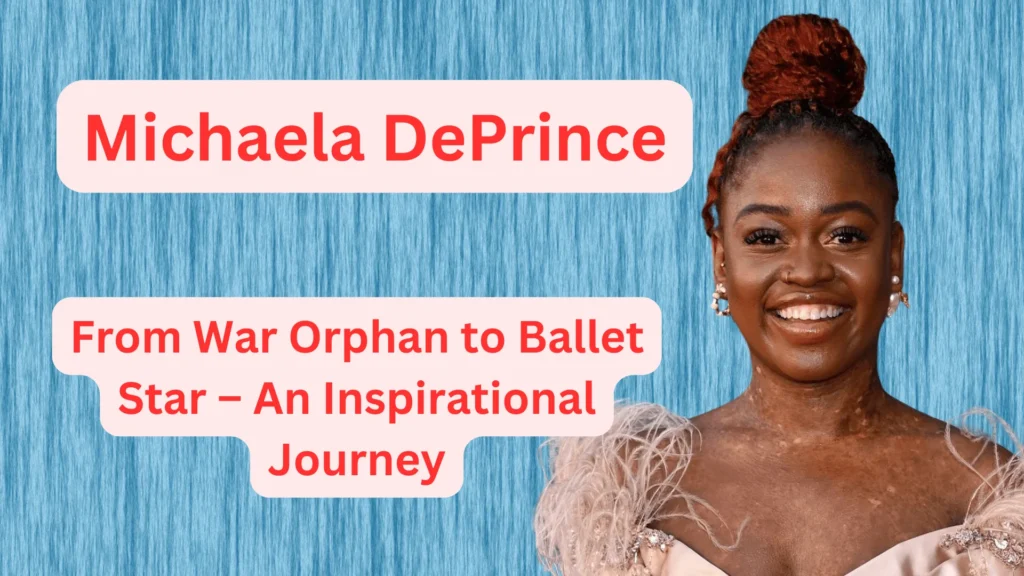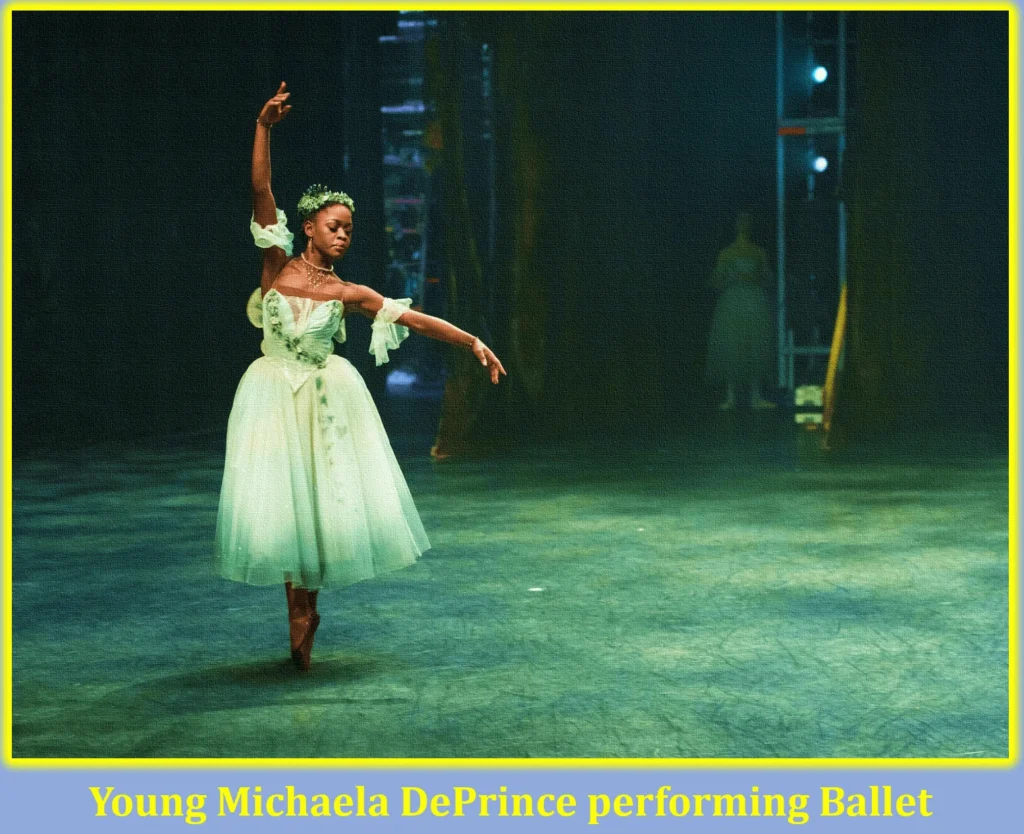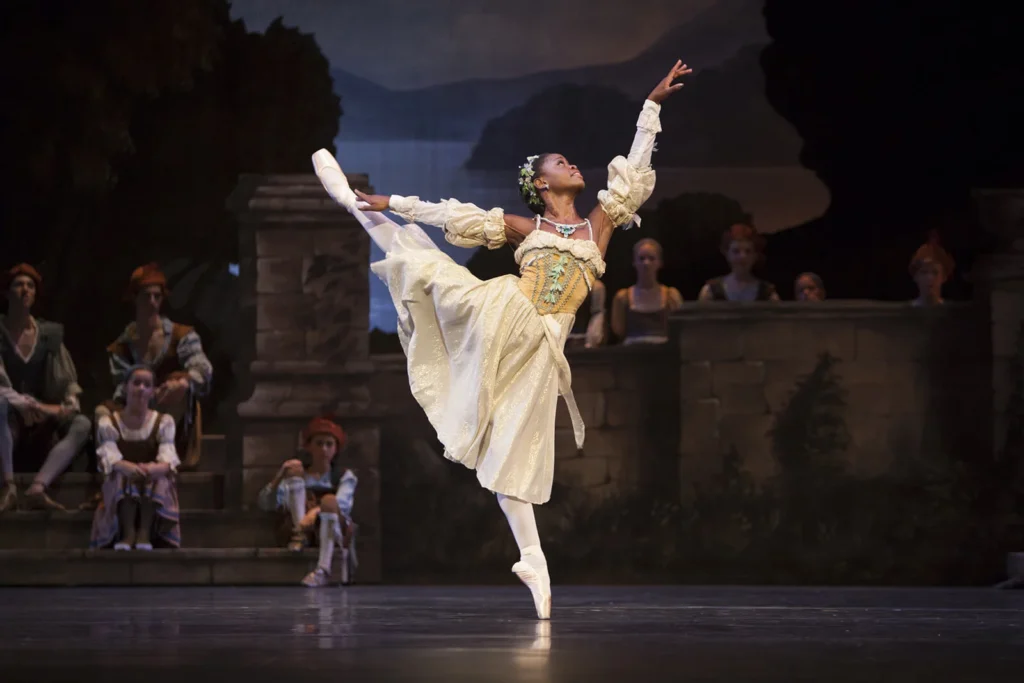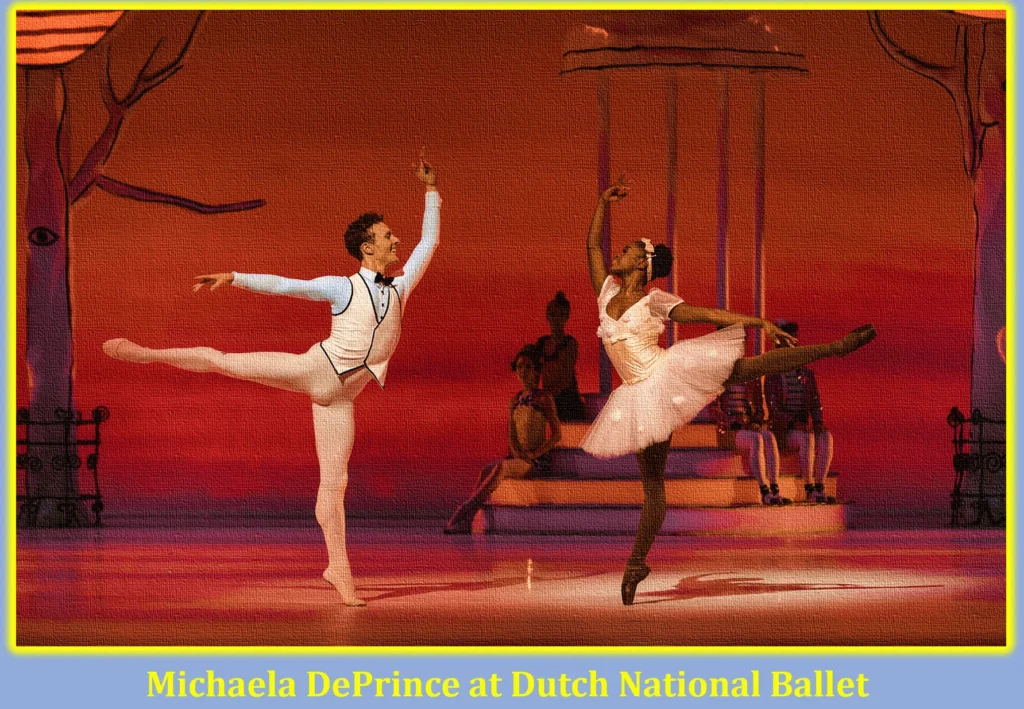
Introduction
Brief Introduction to Michaela DePrince
Michaela Mabinty DePrince, born on January 6, 1995, was a world-renowned ballerina who defied incredible odds to become a symbol of resilience and hope. From her humble beginnings in war-torn Sierra Leone to performing on some of the most prestigious stages globally, Michaela’s journey was nothing short of extraordinary. Despite facing unimaginable hardship in her early life, she rose to fame as one of the most talented dancers of her generation.
Tragically, her journey was cut short as it was announced on Friday through a post on her Instagram page that “On Friday, Michaela Mabinty DePrince’s Instagram profile was updated to reflect her passing. She was a trailblazer and an inspiration to many in the ballet profession. Her age was 29. It is still unclear what caused the death.” With her death, the dance community lost a great visionary who transformed it by dismantling racial, body-image, and obstacle obstacles.
Significance of Michaela DePrince’s Story
Michaela DePrince’s story is one of profound courage, perseverance, and the power of dreams. Born amid the chaos of the Sierra Leone Civil War, Michaela was left orphaned at a young age and suffered from vitiligo, a skin condition that made her the target of discrimination and bullying. Despite these early challenges, she discovered ballet and clung to the dream of dancing professionally—a dream that would eventually take her from a refugee camp to global stardom.
Her rise to fame is not only a testament to her talent but also to her unwavering determination to succeed in an industry historically known for its lack of diversity. Michaela’s impact reaches far beyond the stage; she became a beacon of hope for young dancers, especially those from underrepresented communities, who saw in her a role model who defied stereotypes and shattered expectations. Her life story, immortalized in her autobiography Taking Flight, serves as a source of inspiration for individuals worldwide who are striving to overcome adversity.
As the world mourns the loss of such a vibrant and influential figure, Michaela DePrince’s legacy continues to resonate. Her courage, artistry, and advocacy for diversity in ballet have left an indelible mark on the dance world and beyond.
Early Life and Struggles
Birth and Early Years in Sierra Leone
Michaela Mabinty DePrince was born on January 6, 1995, in Sierra Leone, a West African nation ravaged by civil war at the time of her birth. Her early life was marked by extreme hardship and loss. Born as Mabinty Bangura, she lost both of her parents at a very young age, leaving her orphaned in the midst of brutal conflict. Michaela was placed in an orphanage, where she was ranked as “number 27″—the least favored child—because of her skin condition, vitiligo, which caused patches of her skin to lose pigment. In a society heavily influenced by superstition, her vitiligo made her the target of discrimination, and she was referred to as “the devil’s child.”
Her life at the orphanage was filled with neglect and suffering, but even amid such despair, Michaela discovered hope. A photograph of a ballerina in a magazine, which she found blowing in the wind, ignited a dream in her heart. Despite the hopelessness of her situation, Michaela clung to the belief that she, too, could become a dancer one day.
Adoption and Move to the United States

At the age of four, Michaela’s life took a dramatic turn when she was adopted by Elaine and Charles DePrince, an American couple who brought her to the United States. Her adoption not only gave her a new name, Michaela Mabinty DePrince, but also a new beginning. In her adoptive family, she finally received the love and support that had been absent during her early years. This fresh start offered her the freedom to dream, and more importantly, the resources to pursue those dreams.
Michaela’s new family played a crucial role in nurturing her passion for ballet. Elaine DePrince, who was deeply moved by Michaela’s story and her unwavering determination to dance, enrolled her in ballet lessons soon after they arrived in the U.S. This marked the beginning of Michaela’s transformation from war orphan to world-renowned ballerina.
Dealing with Vitiligo and Bullying
Though Michaela’s move to the United States provided her with safety and opportunity, her struggles with vitiligo persisted. The skin condition caused irregular patches of depigmentation, which made Michaela stand out among her peers. As a young girl, she faced bullying and exclusion from others who did not understand her condition. Despite these challenges, Michaela’s resilience shone through. She channeled the pain of being “different” into her passion for dance, using ballet as a means to express herself and rise above the cruelty she encountered.
Throughout her childhood, Michaela remained determined to prove that her vitiligo—or any other barrier—would not define her future. This resolve would serve as the foundation for her remarkable ascent in the world of ballet, where she broke through both personal and professional challenges.
Rise to Fame in Ballet
Discovery of Ballet at a Young Age

Michaela’s journey to stardom in the ballet world began at age four, shortly after her adoption. Her love for ballet was sparked much earlier, back in Sierra Leone, when she discovered a photograph of a ballerina in a magazine at the orphanage. That image stayed with her, inspiring her to dream of becoming a dancer, even as she endured unimaginable hardships. In the United States, her dream found fertile ground as her adoptive mother recognized her passion and enrolled her in ballet classes.
For Michaela, ballet was more than just an art form—it was a way to escape her past, to redefine herself, and to achieve something extraordinary. She worked tirelessly, practicing with unwavering dedication, determined to overcome every obstacle in her path.
Overcoming Barriers in the Ballet World
Michaela’s rise to prominence in the ballet world was not without its challenges. The world of classical ballet has historically been dominated by rigid standards of appearance and tradition, often excluding dancers who didn’t conform to a narrow ideal of body type, skin color, and background. As a Black ballerina with vitiligo, Michaela was constantly up against stereotypes that dictated who could and couldn’t succeed in the art form.
However, Michaela refused to be defined by those limitations. She faced rejection and discouragement, including being told that she wouldn’t fit into the ballet world due to her race. Despite these obstacles, she persevered, breaking down barriers and defying conventional expectations of what a ballerina should look like. Michaela’s journey through the often-exclusionary world of ballet became a beacon of hope for aspiring dancers of color, proving that talent and determination can overcome prejudice.
Training and Professional Development
Michaela DePrince’s journey in the ballet world began with a simple yet profound inspiration—a magazine cover of a ballerina that she discovered and held onto while living in an orphanage in war-torn Sierra Leone. This singular image ignited a passion within her to pursue ballet, even amidst the most difficult circumstances. Her early years of training in the United States, after being adopted by an American family, marked the start of a disciplined and determined path toward professional ballet.
Early Ballet Training: The Rock School for Dance Education
Upon arriving in the U.S., Michaela began her formal ballet training at The Rock School for Dance Education in Philadelphia, Pennsylvania. This prestigious institution provided her with the foundational skills in classical ballet, a discipline that demands extreme dedication and rigorous practice. Despite the challenges she faced—including cultural adjustments and her struggles with vitiligo—Michaela committed herself fully to mastering her craft. She participated in various competitions, including the renowned Youth America Grand Prix, where she performed with incredible poise and promise.
Concurrently, Michaela pursued her academic studies through Keystone National High School, taking online classes while dedicating most of her time to dance. She earned her high school diploma while balancing an intense ballet training schedule, underscoring her determination and time management skills.
Scholarship to the Jacqueline Kennedy Onassis School of Ballet

Michaela’s performance at the Youth America Grand Prix earned her widespread recognition and opened doors to new opportunities. One of her most significant achievements during this period was being awarded a prestigious scholarship to study at the American Ballet Theatre’s Jacqueline Kennedy Onassis School of Ballet in New York City. This institution is among the most respected in the ballet world, and Michaela’s acceptance marked a critical milestone in her professional development.
The Jacqueline Kennedy Onassis School provided Michaela with specialized training, mentorship from top instructors, and the chance to refine her technique. However, even at this level, she encountered racial discrimination. At the age of eight, she was told that she couldn’t perform as Marie in The Nutcracker because “America’s not ready for a Black girl ballerina.” On another occasion, a teacher bluntly told her adoptive mother that investing in Michaela’s ballet education was a waste of money because Black dancers didn’t have a future in ballet. These experiences, though hurtful, only fueled her determination to prove the doubters wrong.
Breakthrough in First Position and Early Professional Performances
In 2011, Michaela DePrince gained international recognition as one of the stars of the documentary First Position. The film followed six young dancers as they prepared for elite ballet competitions, highlighting the intense dedication and sacrifice required to make it in the world of ballet. Michaela’s story stood out due to her unique background and her persistence in overcoming obstacles that went far beyond the challenges of the dance floor.
That same year, she made her European debut in the production of Abdallah and the Gazelle of Basra with De Dutch Don’t Dance Division, a dance company based in The Hague, Netherlands. This experience expanded her repertoire and gave her exposure to European ballet audiences. In 2012, Michaela returned to the Netherlands to perform as the Sugar Plum Fairy in The Nutcracker at the Lucent Dance Theatre, a role traditionally reserved for white ballerinas. Her ability to capture the essence of this iconic role was a testament to her growing versatility and strength as a performer.
Joining the Dance Theatre of Harlem and Professional Debut
In 2012, Michaela graduated from the American Ballet Theatre’s Jacqueline Kennedy Onassis School, a milestone that officially launched her professional career. She joined the Dance Theatre of Harlem, where she was the youngest member of the company. Founded by Arthur Mitchell, the Dance Theatre of Harlem was a pioneering institution, known for promoting diversity in ballet. Michaela’s addition to the company was a significant moment, not just for her career but for the ongoing conversation about diversity and inclusion in ballet.
Her professional debut came later that year when she performed the role of Gulnare in the production of Le Corsaire by Mzansi Productions and the South African Ballet Theatre. The premiere, held in Johannesburg, South Africa, marked a full-circle moment for Michaela, as she returned to the African continent to perform for the first time since her adoption. Her portrayal of Gulnare was praised for its elegance, technical precision, and emotional depth, earning her acclaim from critics and audiences alike.
Michaela DePrince’s training and early professional development are a testament to her indomitable spirit and exceptional talent. From her discovery of ballet as a child in Sierra Leone to her graduation from one of the world’s most prestigious ballet schools, Michaela’s journey is defined by relentless dedication. Her accomplishments, despite the prejudice and challenges she faced, reflect not only her remarkable skills but also her role in changing the face of ballet for future generations. Her story of perseverance and success continues to inspire countless aspiring dancers worldwide, reminding them that passion, hard work, and resilience can help overcome even the toughest barriers.
Career Highlights
Joining the Dutch National Ballet

In July 2013, Michaela DePrince joined the junior company of the Dutch National Ballet, based in Amsterdam. This was a significant milestone in her career, as it marked her entry into a world-class ballet institution. A year later, in August 2014, Michaela was promoted to the main company as an éleve (student), and her rise within the ranks was rapid and well-deserved. In 2015, she was promoted to coryphée (a leading member of the corps de ballet), and just a year later, she became a grand sujet. By the end of 2016, Michaela had achieved soloist status—an extraordinary feat considering her relatively short time with the company.
As the first dancer of African origin to join the Dutch National Ballet, Michaela broke new ground and challenged the traditional norms of what a ballerina could be. Her presence in the company not only brought visibility to dancers of color in classical ballet but also inspired a new generation of aspiring dancers from diverse backgrounds. Michaela’s grace, technical skill, and powerful stage presence made her a standout in every performance she took part in, including significant roles such as Odile in Swan Lake and Clara in The Nutcracker.
Entry into Boston Ballet
In 2021, Michaela made a pivotal career move by joining the Boston Ballet as a second soloist. The transition to Boston was a strategic one for Michaela, as the company had built a reputation for fostering diversity and inclusivity. Boston Ballet’s repertoire, combined with the presence of many talented Black dancers, was a perfect match for Michaela’s artistic vision and personal values. She was drawn to the supportive culture that allowed her to explore new roles and deepen her craft. Her performance in Coppélia, a ballet film that blends live dance with animation, showcased her versatility and ability to bridge classical ballet with modern storytelling techniques.
Notable Performances and Roles
Throughout her career, Michaela DePrince delivered unforgettable performances that left an indelible mark on audiences and critics alike. Among her most significant roles was her performance in Beyoncé’s Lemonade, where she featured in the “Hope” sequence. This high-profile appearance brought her incredible talent to a broader audience outside the traditional ballet world. Her performances at the Dutch National Ballet included lead roles in Swan Lake, The Nutcracker, and La Bayadère, where her technical brilliance and emotive storytelling captivated both audiences and critics.
In Coppélia, Michaela took on the leading role in the 2021 ballet film, a reimagining of the classic tale by E.T.A. Hoffmann. The modernized adaptation featured live dance interwoven with animation, demonstrating Michaela’s ability to innovate within the classical ballet framework. Her role in the film was another testament to her artistry and how she effortlessly blended traditional ballet with contemporary elements, further expanding her global reach.
Media Appearances and Documentaries
Michaela’s rise to fame wasn’t just limited to her performances on stage. She gained widespread recognition through media appearances and documentaries that captured her incredible life story. In 2011, she was featured in the critically acclaimed documentary First Position, which followed young ballet dancers as they competed in the prestigious Youth America Grand Prix. Michaela’s journey from a war orphan to a rising star in the ballet world resonated deeply with audiences, making her one of the standout stars of the film.
In addition to First Position, Michaela also made an impactful appearance in Beyoncé’s Lemonade visual album in 2016. Her graceful and powerful performance in the “Hope” sequence symbolized resilience and transformation, themes that aligned perfectly with her personal journey. Her media appearances helped amplify her story to a wider audience and positioned her as a role model not just in the ballet community, but also in the broader cultural sphere.
Advocacy and Inspirational Work
Promoting Diversity in Ballet
Michaela DePrince was not just a talented dancer; she was also an advocate for diversity and inclusion within the ballet world. Throughout her career, she consistently spoke out about the lack of representation of dancers of color in classical ballet and worked to break down these barriers. By simply being on stage, Michaela was defying stereotypes and shattering the traditional image of what a ballerina “should” look like. Her presence inspired young dancers, especially from underrepresented communities, to pursue ballet, knowing that they, too, had a place in the art form.
Michaela also took part in several initiatives to promote diversity in ballet schools and professional companies. She believed strongly in the power of visibility and often highlighted the importance of offering opportunities to dancers who may not fit the classical mold but who bring extraordinary talent and passion to the stage.
Work as an Author and Motivational Speaker

In 2014, Michaela published her autobiography Taking Flight: From War Orphan to Star Ballerina, which recounted her extraordinary journey from an orphanage in Sierra Leone to becoming one of the world’s most famous ballerinas. The book provided a deeply personal look at the challenges Michaela faced throughout her life and how she overcame them with perseverance and grace. Taking Flight became a source of inspiration for countless readers, particularly young women and aspiring dancers, who saw in Michaela a living example of what can be achieved with determination and passion.
In addition to her work as an author, Michaela became a sought-after motivational speaker. She shared her story with audiences around the world, speaking at schools, conferences, and public events. Her speeches, often filled with powerful messages about resilience, overcoming adversity, and pursuing one’s dreams, resonated deeply with people from all walks of life. She consistently used her platform to inspire and uplift others, always emphasizing that no matter where someone starts in life, they can achieve greatness.
Philanthropy and Work with Charities
Michaela never forgot her roots and used her platform to give back to those in need. In 2019, she produced a gala for War Child Holland, an organization that supports children affected by armed conflict. The event raised more than half a million dollars, underscoring Michaela’s commitment to helping others who faced struggles similar to her own early in life. Her philanthropic work was deeply personal, as she knew firsthand the pain of being a child in the midst of war and conflict.
Michaela’s involvement with charities wasn’t limited to War Child Holland; she was also a passionate advocate for causes that supported orphans, refugees, and marginalized communities. She remained actively engaged in raising awareness and funds for these causes throughout her career, always ensuring that her success on the stage translated into meaningful contributions to the world.
Michaela’s Legacy and Impact
Breaking Boundaries in the Dance World
Michaela DePrince’s legacy is defined by her remarkable ability to break barriers in a historically rigid and exclusive art form. Classical ballet has long been seen as a space with limited diversity, often adhering to Eurocentric beauty standards and ideal body types. Michaela, with her unique background and unparalleled talent, challenged these norms. As a Black ballerina with vitiligo, she faced both visible and invisible barriers. However, her resilience, talent, and unshakable determination not only allowed her to excel in the ballet world but also opened doors for aspiring dancers of color.
Michaela’s presence on the global stage forced the ballet industry to confront its lack of representation. She showed that talent transcends race, skin color, and background, proving that ballet can and should be inclusive of all. By becoming a soloist with the Dutch National Ballet and later joining the Boston Ballet, Michaela created a path for future generations of dancers from underrepresented backgrounds to believe in their potential, regardless of the limitation’s society might impose on them.
Her impact extends beyond the roles she performed Michaela sparked crucial conversations about diversity, inclusivity, and what it means to redefine the boundaries of classical art. She became a symbol of change, illustrating that excellence in ballet can come in all shades and forms.
Inspiring the Next Generation
Michaela DePrince’s legacy as an inspiration to the next generation is undeniable. Her journey, from a war-torn country to the world’s most prestigious ballet stages, has become a source of motivation for countless individuals, especially young dancers and those overcoming personal hardships. Michaela didn’t just represent success in ballet; she embodied perseverance, hope, and the belief that no dream is unattainable.
As an outspoken advocate for breaking down barriers in ballet, Michaela has inspired young dancers, particularly those of color, to pursue their dreams in spaces where they may have previously felt unwelcome. Her autobiography Taking Flight has served as a guiding light for many, providing a narrative of triumph against overwhelming odds. The book’s widespread success also highlights her ability to connect with people far beyond the world of dance, giving them the courage to embrace their own journeys, no matter how difficult.
Michaela’s influence isn’t limited to the stage or the pages of her book. Her work as a motivational speaker, advocate, and philanthropist further demonstrates her commitment to empowering others. She understood the transformative power of representation, and through her actions, she gave hope to a new generation of dancers who may have once felt that ballet was not a space for them. Her story will continue to serve as a beacon of hope and inspiration for those who dare to dream, no matter where they come from or what challenges they face.
Conclusion & FAQs
Michaela DePrince’s life is a testament to the power of resilience, hope, and perseverance. From her harrowing beginnings as an orphan in war-torn Sierra Leone to becoming a world-renowned ballerina, Michaela’s journey is one of extraordinary triumph. Overcoming immense challenges—including vitiligo, bullying, and societal barriers—she rose to prominence in the ballet world, breaking boundaries and challenging long-standing stereotypes. Her time at the Dutch National Ballet, where she became the first dancer of African origin, and her move to the Boston Ballet solidified her place as one of the most talented and influential dancers of her generation.
Through her performances, advocacy for diversity in ballet, work as an author, and philanthropic efforts, Michaela left a legacy that goes far beyond the stage. Her life stands as a powerful example of what can be achieved when passion, talent, and determination are combined with an unshakable belief in oneself.
Michaela DePrince’s impact on the ballet world, and on society at large, will be felt for generations to come. She has changed the way ballet views diversity and opened up new possibilities for dancers from all backgrounds to take their place on the world’s most prestigious stages. Beyond her technical brilliance and stage presence, Michaela’s legacy lies in her ability to inspire others—showing that no dream is too big and no challenge too great to overcome.
Her story serves as a reminder that, even in the face of overwhelming adversity, hope and perseverance can lead to greatness. Michaela DePrince will forever be remembered not only as an exceptional ballerina but as a trailblazer, advocate, and symbol of resilience.
Frequently Asked Questions (FAQs)
Who is Michaela DePrince?
Michaela DePrince was a world-renowned ballerina, best known for her roles with the Dutch National Ballet and Boston Ballet. Born in Sierra Leone, Michaela overcame significant adversity, including being orphaned during the civil war, suffering from vitiligo, and dealing with discrimination in the ballet world, to become a global symbol of hope and perseverance.
What were Michaela DePrince’s most notable achievements?
Michaela achieved numerous accolades throughout her career. She became a soloist at the Dutch National Ballet, appeared in the documentary First Position, performed in Beyoncé’s Lemonade, and joined the Boston Ballet as a second soloist. She also published her autobiography Taking Flight, which has inspired countless individuals.
How did Michaela DePrince promote diversity in ballet?
Michaela was an outspoken advocate for diversity in the ballet world. As one of the few Black dancers in prestigious ballet companies, she broke down racial barriers and encouraged young dancers from underrepresented communities to pursue their passion for ballet. Her career helped shift perceptions of what a ballerina can look like and opened doors for future generations of dancers.
What is Michaela DePrince’s legacy?
Michaela DePrince’s legacy is one of resilience, hope, and transformation. She changed the ballet world by challenging long-standing stereotypes about race and body image. Michaela inspired countless individuals, not just in the ballet community, but around the world, through her performances, advocacy, and philanthropy.
What books has Michaela DePrince written?
Michaela authored the autobiography Taking Flight: From War Orphan to Star Ballerina, which chronicles her incredible journey from an orphan in Sierra Leone to an internationally acclaimed ballerina. The book has inspired readers worldwide and offers a message of hope and perseverance.
What organizations was Michaela DePrince involved in?
Michaela was deeply involved in charitable work, particularly with organizations like War Child Holland, which supports children affected by armed conflict. In 2019, she produced a gala for the organization that raised over half a million dollars to aid children and youth in war-torn regions.
How did Michaela DePrince inspire the next generation?
Michaela inspired the next generation by sharing her story of overcoming adversity and breaking barriers in the ballet world. Her success as a Black ballerina in a predominantly white industry, along with her advocacy for diversity, encouraged young dancers of all backgrounds to pursue their dreams.
